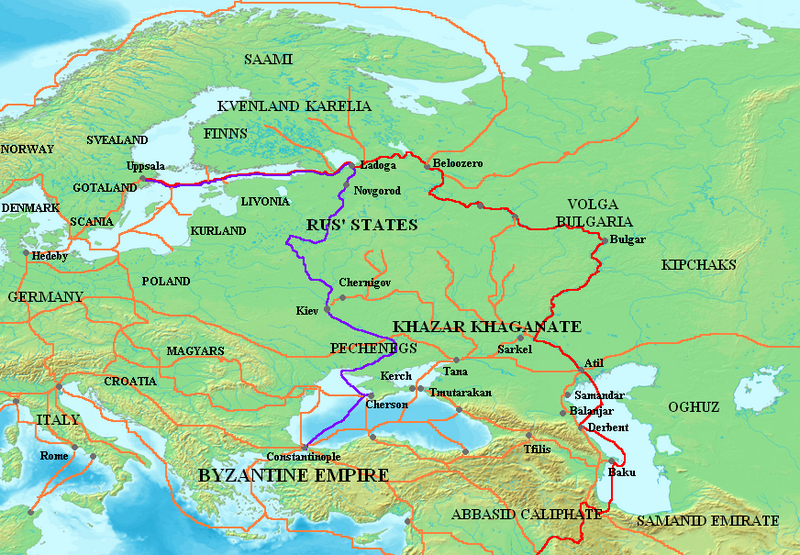پرونده:Varangian routes.png

اندازهٔ این پیشنمایش: ۸۰۰ × ۵۵۵ پیکسل. کیفیتهای دیگر: ۳۲۰ × ۲۲۲ پیکسل | ۶۴۰ × ۴۴۴ پیکسل | ۸۷۲ × ۶۰۵ پیکسل.
پروندهٔ اصلی (۸۷۲ × ۶۰۵ پیکسل، اندازهٔ پرونده: ۸۵۹ کیلوبایت، نوع MIME پرونده: image/png)
تاریخچهٔ پرونده
روی تاریخ/زمانها کلیک کنید تا نسخهٔ مربوط به آن هنگام را ببینید.
| تاریخ/زمان | بندانگشتی | ابعاد | کاربر | توضیح | |
|---|---|---|---|---|---|
| کنونی | ۳ اکتبر ۲۰۲۳، ساعت ۱۱:۲۹ |  | ۸۷۲ در ۶۰۵ (۸۵۹ کیلوبایت) | OrionNimrod | Restore original: "Wallachians" added by Romanian user, however it was no Wallachia in the 8-11th c: British historian, Martyn Rady - Nobility, land and service in medieval Hungary (p91–93): the sources before the 13th century do not contain references to Vlachs anywhere in Hungary and Transylvania or in Wallachia. Byzantine sources mentioned Vlachs all deep in the Balcan. Also map should make by academic historians not by personal POV. |
| ۱۶ اوت ۲۰۲۳، ساعت ۱۸:۲۳ |  | ۸۷۲ در ۶۰۵ (۷۹۹ کیلوبایت) | Claude Zygiel | In one hand there are Byzantine sources which mention the Vlachs, secondly it is not because other sources do not mention them that they did not exist. In the other hand, the Hungarian theory which affirms that "the absence of proof is proof of absence", that this group disappeared for a thousand years, and that it would have been the only one, among all the peoples of the region , to not being able to cross the Balkans, the Danube and the Carpathians (while they were nomadic shepherds), is u... | |
| ۲۵ ژوئیهٔ ۲۰۲۳، ساعت ۱۰:۵۴ |  | ۸۷۲ در ۶۰۵ (۷۹۴ کیلوبایت) | OrionNimrod | "Wallachians" added by Romanian user, however it was no Wallachia in the 8-11th c: British historian, Martyn Rady - Nobility, land and service in medieval Hungary (p91–93): the sources before the 13th century do not contain references to Vlachs anywhere in Hungary and Transylvania or in Wallachia | |
| ۲۶ ژوئن ۲۰۲۳، ساعت ۰۷:۲۹ |  | ۸۷۲ در ۶۰۵ (۷۹۹ کیلوبایت) | Johannnes89 | Reverted to version as of 16:47, 18 April 2023 (UTC) crosswiki image spam, often containing historical inaccuracies | |
| ۲۵ ژوئن ۲۰۲۳، ساعت ۲۳:۵۳ |  | ۸۷۲ در ۶۰۵ (۱٬۰۱۷ کیلوبایت) | Valdazleifr | Fixed minor errors | |
| ۱۸ آوریل ۲۰۲۳، ساعت ۱۶:۴۷ |  | ۸۷۲ در ۶۰۵ (۷۹۹ کیلوبایت) | Claude Zygiel | There was no Wallachia but Wallachians. The theory that speakers of Eastern Romance languages disappeared for a thousand years between 275 and 1300 is only supported by Hungarian nationalist authors. | |
| ۲۵ نوامبر ۲۰۲۲، ساعت ۱۲:۴۱ |  | ۸۷۲ در ۶۰۵ (۷۹۴ کیلوبایت) | OrionNimrod | Reverted to version as of 15:59, 8 March 2009 (UTC) It was no Wallachia in the 8-11th century | |
| ۲۱ مهٔ ۲۰۱۵، ساعت ۱۲:۴۴ |  | ۸۷۲ در ۶۰۵ (۷۹۹ کیلوبایت) | Spiridon Ion Cepleanu | Dvina & Wisla-Dnestr route, some details | |
| ۸ مارس ۲۰۰۹، ساعت ۱۵:۵۹ |  | ۸۷۲ در ۶۰۵ (۷۹۴ کیلوبایت) | Mahahahaneapneap | Compressed | |
| ۱۸ ژانویهٔ ۲۰۰۷، ساعت ۲۳:۱۵ |  | ۸۷۲ در ۶۰۵ (۸۵۹ کیلوبایت) | Electionworld | {{ew|en|Briangotts}} == Summary == Map showing the major Varangian trade routes, the Volga trade route (in red) and the Trade Route from the Varangians to the Greeks (in purple). Other trade routes of the 8th-11th centuries shown in orange |
کاربرد پرونده
صفحههای زیر از این تصویر استفاده میکنند:
کاربرد سراسری پرونده
ویکیهای دیگر زیر از این پرونده استفاده میکنند:
- کاربرد در af.wikipedia.org
- کاربرد در ar.wikipedia.org
- کاربرد در ast.wikipedia.org
- کاربرد در az.wikipedia.org
- کاربرد در be-tarask.wikipedia.org
- کاربرد در be.wikipedia.org
- کاربرد در bg.wikipedia.org
- کاربرد در ca.wikipedia.org
- کاربرد در ckb.wikipedia.org
- کاربرد در cs.wikipedia.org
- کاربرد در cv.wikipedia.org
- کاربرد در cy.wikipedia.org
- کاربرد در de.wikipedia.org
- کاربرد در el.wikipedia.org
- کاربرد در en.wikipedia.org
نمایش استفادههای سراسری از این پرونده.


